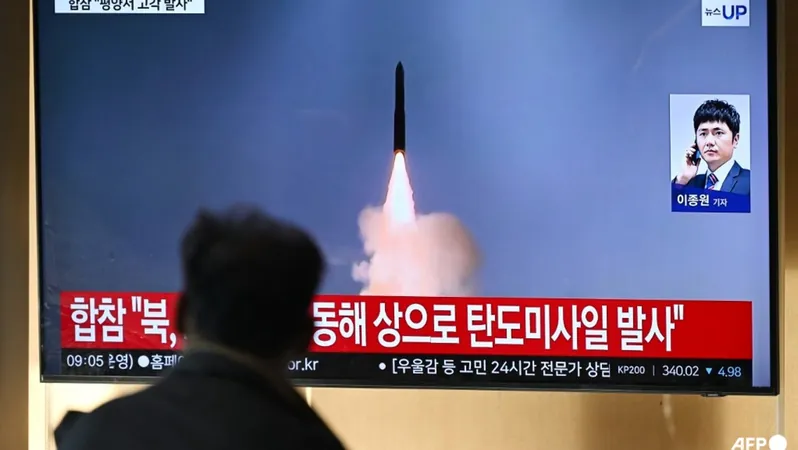
North Korea Unleashes the Hwasong-19: A Game-Changing Intercontinental Ballistic Missile
2024-11-01
Author: Rajesh
SEOUL: In a display of undeniable military prowess, North Korea has successfully launched a significant new addition to its arsenal: the Hwasong-19, a colossal solid-fuel intercontinental ballistic missile (ICBM). According to state media, this momentous launch on Thursday marks a new chapter in the North's military ambitions, coinciding with increasing tensions surrounding its involvement with Russia amid the ongoing conflict in Ukraine.
This latest missile test reportedly soared to unprecedented heights, outpacing any previous launches from the North. Intelligence from South Korea and Japan confirmed that the missile’s trajectory reached deep into space before it splashed down in the waters between Japan and Russia.
Celebrating the achievement, North Korean state news agency KCNA proclaimed the Hwasong-19 as "the world's strongest strategic missile." North Korean leader Kim Jong Un, who oversaw the launch, emphasized the missile's significance, declaring that it showcased the "hegemonic position" the country has attained in nuclear delivery systems.
Despite the show of strength, questions linger regarding North Korea's technological capabilities, particularly its ability to accurately guide the missile and ensure the safe re-entry of a nuclear warhead after atmospheric re-entry. Nonetheless, the Hwasong-19 signifies North Korea's intention to develop a weapon capable of reaching nearly any target within the continental United States.
The timing of this missile launch is particularly provocative, occurring just days before a highly anticipated U.S. presidential election. The act has drawn widespread condemnation from Washington and its allies, spurring swift responses from South Korea, Japan, and members of the European Union, alongside criticism from United Nations Secretary-General António Guterres.
On the global stage, Ukrainian President Volodymyr Zelenskiy voiced concerns over the perceived minimal response from Western allies regarding Moscow's enlistment of North Korean troops in the Ukraine conflict. This situation raises alarming prospects of sensitive military technologies potentially exchanged between the two nations.
As the Pentagon continues to assess the implications of the missile launch, U.S. Defense Secretary Lloyd Austin reported no indications of Russian involvement in this specific test. The KCNA claimed that the flight posed no threat to neighboring countries and framed the launch as a necessary military step amidst perceived threats from adversaries.
North Korea's military strategy continues to evolve. Alongside the Hwasong-19, the Hwasong-18, which debuted last year, is also solid-fuel powered, adding to the North's growing inventory of hard-to-detect missile systems. Solid-fuel missiles hold several operational advantages; they eliminate the need for fuel loading right before launch and provide a more streamlined, safer operational framework.
Visuals disseminated by KCNA showcased the immense missile being launched from a canister mounted on a transporter-erector-launcher (TEL), underscoring the mobilization capabilities of North Korea's missile forces. Additional footage seemed to capture first-hand imagery from the missile itself during important phases of the flight.
According to the reports, the Hwasong-19 achieved a staggering flight distance of 1,001.2 kilometers, remaining airborne for an extraordinary 5,156 seconds and reaching a peak altitude of 7,687.5 kilometers before its descent into the sea off Korea's east coast. As global leaders grapple with this provocative development, the question of the international community's next steps hangs precariously in the balance. What will be the repercussions as North Korea continues its pursuit of military dominance? Stay tuned as this historic story unfurls.





 Brasil (PT)
Brasil (PT)
 Canada (EN)
Canada (EN)
 Chile (ES)
Chile (ES)
 España (ES)
España (ES)
 France (FR)
France (FR)
 Hong Kong (EN)
Hong Kong (EN)
 Italia (IT)
Italia (IT)
 日本 (JA)
日本 (JA)
 Magyarország (HU)
Magyarország (HU)
 Norge (NO)
Norge (NO)
 Polska (PL)
Polska (PL)
 Schweiz (DE)
Schweiz (DE)
 Singapore (EN)
Singapore (EN)
 Sverige (SV)
Sverige (SV)
 Suomi (FI)
Suomi (FI)
 Türkiye (TR)
Türkiye (TR)